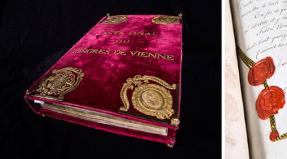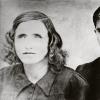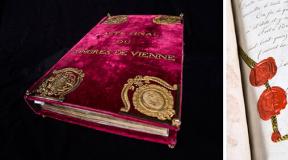Roo "Academy of Russian Symbols" Mars. Marine Engineering School Final exams and defense of diploma projects
After Menshikov's arrest, the palace was transferred to the treasury. The Office of the Kronstadt Canal was located here, then the Customs, then other institutions.
On May 31, 1771, after the fire of the Naval Cadet Corps at the Military District, it was transferred to the Kronstadt Italian Palace, in connection with which a number of reconstructions were carried out. () The Naval Cadet Corps was located here from 1771 to 1798. (Green A.I....)
Here, on February 15, 1772, a church was consecrated in the name of St. Nicholas the Wonderworker. The church of the same name existed at the corps since 1761 and was located in the corps building on Vasilyevsky Island. The corps remained in Kronstadt until 1796, when, by order of Paul I, it was returned to St. Petersburg. The church was also moved to a new building in the capital. (p. 185)
Emperor Pavel Petrovich, having ascended the throne, paid attention to the fleet and ordered the transfer of naval cadets from Kronstadt to St. Petersburg. At the same time, he established two Navigation Schools, one for the Baltic and the other for the Black Sea Fleet. A house in Kronstadt, which had previously housed the Naval Cadet Corps, was assigned to house the navigator classes of the school. (Green A.I. Historical sketch of the Navigation School 1798-1871, Kronstadt, 1872. P.5-6)
In 1798, the Navigation School was located in the Italian Palace. In 1826, the Navigation School was renamed into the Navigation Company, and on March 10, 1827 into the First Navigation Half-Crew. In 1829-1831 The palace was renovated according to the drawings of the architect. E. Ahnerta. The interiors of the church hall were designed by architect. V. Stasov. The single-tier iconostasis was built in classicism style.
In 1843, Nicholas I decided to rebuild the building. The restructuring commission was headed by the Chief of the Crew, Major General A.K. Davydov. On May 19, 1843, the project for rebuilding the palace of the architect was approved. A. N. Akutina.
According to the new project, a large extension of 18 axes was added to the western building of the palace. The building that previously connected the western and eastern buildings was demolished, and a new covered passage was built in its place to the north. A gallery is attached to the southern side of the courtyard building. An 8-axis extension for the church was made to the building, perpendicular to the Peter the Great Canal. (. pp.75-80)
The former church was transferred to the Training Crew in the Minikhov House, and a new house church was built in one of the premises of the Italian Palace, consecrated on February 1, 1847. It was located in a large double-height hall. Due to the absence of a belfry, a small bell was hung on a pole in the school yard.
Initially, the church, like all churches of educational institutions, was under diocesan jurisdiction and under the supervision of the Ministry of Public Education. In 1907, the church was transferred to the jurisdiction of the Protopresbyter of the military and naval clergy. (pp. 186-187)
On the walls of the school were installed black marble boards with the names of navigators killed and died from wounds, starting from the Battle of Chesme, and gray boards with the names of those killed in the line of duty. (p. 186)
In 1846, a fourth floor superstructure with 11 axes was designed above the central part of the main southern building. An astronomical gazebo is erected above it.
According to the project by architect. Reimers in 1847, stone service buildings were erected on the site - a bathhouse, a laundry, a stable with sheds and glaciers.
Construction work continued from 1843 to 1848.
On May 9, 1856, the half-crew was again renamed the Navigation School, which in 1867 was merged with the artillery school, under the name of the Navigation-Artillery School. In 1872 it became part of the Technical School of the Maritime Department. (Green A.I. Historical sketch of the Navigation School 1798-1871, Kronstadt, 1872. P. 5-6). Since 1898 - Marine Engineering School of Emperor Nicholas I.
For the latter, a large new building was added, extending the main facade along Pomorskaya (Makarovskaya) Street. to the west. Another building was added at an angle on the north side. The facades of the new buildings completely repeated the old building, uniting into one whole.
In 1910, a new signal tower of a slightly different type was built to replace the outdated one. (. pp.75-80)
In 1926, there was a fire in the building, after which reconstruction was carried out, and the building itself received the status of the House of Officers.
The theater of the Baltic Fleet was also located here. In 2011 the theater moved.
In 1974, restoration of the House of Officers (Italian Palace) began. During the restoration of the palace, vestibules that distorted its facades were removed, and lost architectural details were restored (modeling on the pediment, etc.). (.p.131)
(text by Mary, Natalia)
Engineer-Rear Admiral M.V. Korolev was appointed the first head of the school in April 1952. By the beginning of the first academic year - October 1, 1952 - two faculties were created. On April 30, 1953, the diesel department was transferred to the school from the Higher Naval Engineering School named after F.E. Dzerzhinsky.
Construction of the main building of the academic building was completed in 1960. The architectural ensemble includes five four-story buildings connected by colonnades with internal greenhouse courtyards. In terms of size and volume of internal premises, the educational building is one of the largest buildings (the total volume of internal premises is more than 200,000 cubic meters) in Sevastopol.
The school was the main center for training officer engineering personnel for the ocean-going nuclear fleet. The educational institution had the strongest teaching staff. The material and technical base for training naval power engineers for the USSR nuclear fleet included its own research reactor IR-100, a full-scale onboard complex of a 2nd generation submarine nuclear power plant, full-scale simulators, research thermo-hydrodynamic stands, and a powerful computer center.
The school conducted scientific research on current problems of ship nuclear power, hydraulics, and thermal physics at departments and in research laboratories. Scientific and technical conferences, visiting sessions of the USSR Academy of Sciences on thermophysical and hydrodynamic aspects of the problem of safety of ship nuclear power plants, and meetings of the Scientific Council of the Academy of Sciences on ocean hydrophysics were held. Since 1965, the school published the “Collected Works of SVVMIU”.
In 1985, the chemistry department of the Caspian Higher Naval Red Banner School named after S. M. Kirov was transferred to the school.
Over 40 years, more than 11,000 engineer officers were released from its walls; many of the graduates were awarded government awards and received state prizes. Graduates of the Sevastopol Higher Naval Engineering School, while serving in the Navy, participated in eliminating the consequences of accidents on nuclear submarines. More than two dozen graduates were awarded admiral ranks.
The school ceased to exist in 1992, after the collapse of the USSR, and was included in the structure. Before the annexation of Crimea to the Russian Federation, the infrastructure of the Sevastopol Higher Naval Engineering School (maritime practice building, survivability range, diving range) was destroyed and was partially in disrepair.
A faculty for training specialists for the nuclear energy industry in Ukraine was formed on the basis of SVVMIU. On August 2, 1996, by resolution of the Cabinet of Ministers of Ukraine No. 884, the faculty was transformed into (SINAEiP), to which the infrastructure of the IR-100 nuclear reactor was transferred. At the end of March 2014, the IR-100 nuclear reactor was shut down and mothballed. as the Institute of Nuclear Energy and Industry.
According to the Federal Target Program for the Development of Crimea and Sevastopol until 2020, funds are provided for the reconstruction of the educational building, which is associated with work in the field of energy.
In December 2017, the battle banner of the Sevastopol VVMIU was transferred for storage to the Black Sea Fleet Museum.
In the first part, based on the memoirs of V.P. Kostenko “On the Eagle” in Tsushima,” I would like to talk about how the training of shipbuilding engineers took place at the Kronstadt Naval Engineering School before the Russo-Japanese War.
Features of training
All those enrolled in the school received full government support. First-year students of both departments listened to lectures together, and the separation of shipbuilders and mechanics began from the second year.
All those accepted were required to serve in the navy for 4 ½ years upon graduation to cover the costs of their education and maintenance for 3 special courses.
The school was a closed educational institution, and the presence of students at all lectures was mandatory. Progress checks were carried out periodically at regular rehearsals and at spring transition exams after the end of the academic year (using a twelve-point system).
Every day, after the end of the day's classes, students were allowed to leave the school until 11 o'clock in the evening. On Saturdays, pupils had the right to travel to St. Petersburg until 11 o’clock on Sunday evening.
From the second year, mechanics went sailing in the Baltic Sea on ships of the training detachment of the Engineering School, and the first year practiced in Kronstadt on the old gunboat “Tucha”.
In the last - fourth year, shipbuilders and mechanics devoted the entire academic year to drawing up diploma projects in their specialty. Defense of projects and final exams took place with the participation of a special commission appointed by the Main Naval Staff.
The production of graduates and their release into the fleet took place in a solemn atmosphere on “Tsar’s Day” on May 6th. Shipbuilders received the rank of “junior assistant shipbuilder” with one star on a narrow silver shoulder strap, corresponding to the rank of midshipman of naval officers, and were assigned to available vacancies in naval ports for the construction and repair of ships. Mechanics were released into the navy with the rank of “junior mechanical engineer.”
At the school, lectures began at 8 o'clock in the morning, and until 3 o'clock 6 lectures were held daily, and after 6 o'clock in the evening work began in workshops and laboratories.
Since lectures and interviews with teachers are mandatory, training courses are usually learned before rehearsals and almost no time is required to prepare for testing.
A compulsory and well-organized three-month summer internship consolidates the knowledge accumulated in theoretical courses.
Vacations and recreation take no more than one and a half months per year, leaving 10 ½ months for study.
With a wake-up time of 6 ½ o'clock in the morning and the end of the working day at 11 o'clock in the evening, each day there are more than 16 hours of time for lectures, classes, reading and walking.
It is also impossible not to note the influence that a close connection with the life of the fleet, port and factories has. The Navy trains young personnel for itself. Cadets in the port have access to all ships under construction, armed and ready in the roadstead.
The school's students had the opportunity to visit new ships in their free time, study their internal layout and equipment, and receive the latest information from the personnel. This lively and direct connection with the daily life of the fleet involved both shipbuilders and mechanics from school in the circle of life of the fleet and forced them to become imbued with its urgent tasks.
Ship mechanics and officers always carefully introduced us to all the new items in ship equipment. This communication with the fleet personnel drew the younger generation of specialists into the circle of current life and interests of the naval forces.
Entrance exams
Out of 50 who passed competitive exams<на кораблестроительное отделение>5 people were enrolled. Those who did not get into the shipbuilding department through the competition could, if they wished, enter the mechanical department. 32 of the 80 who took the exams were accepted as mechanics.
Internship after the first year of study
In the summer, after transitional exams, shipbuilders went to St. Petersburg for a three-month practical training and were distributed among the Admiralty factories. At the end of the summer practice, a test exam was carried out by a commission of engineers of the St. Petersburg port, after which the students were given a month's leave.
Every day at 9 o'clock in the morning we set off across the Nikolaevsky Bridge along the left bank of the Neva to the Admiralty factories. One group, which worked in practice for the first year, remained at the New Admiralty plant, while the other two courses went to the Galerny Island shipyard.
In the first year of practice, we had to study the construction of wooden keel boats in the boat workshop for three months, and then familiarize ourselves with the location and equipment of all the workshops for cold and hot processing of sheet and profile steel used for the construction of ship hulls.
Next, the program included the study of plaza work and hull assembly on a slipway. By the end of the internship, a detailed written report was required, illustrated with copies of drawings, hand sketches, drawings and photographs. To collect all the information, copies of drawings and technical data, we could contact the engineers in the builders' offices, the designers in the drawing rooms and the foremen on the buildings, as well as all the workers at the machines and assemblers on the stocks.
Internship after the second year of study
In 1902<после второго года обучения>Our practical classes turned out differently. We were assigned to the construction of the battleship "Eagle", and we ended up with Mikhail Karlovich Yakovlev. Preparations were underway for the launch of the ship, we got the opportunity to see the foundation being laid, the skids being prepared and the skids being assembled between the ship's hull and the skids. Of particular interest was the assembly of the spears in the bow and stern.
By the end of the summer, we had to study the entire internal layout of the battleship, its ventilation and drainage systems, the flooding of the cellars and the tilting of the ship from the kingstons. Yakovlev often tested our knowledge of all diagrams of ship systems. This second year of practice greatly expanded our understanding of all the interconnected devices of the ship and more fully illuminated the future responsibilities of the ship engineer during construction.
During the summer, we also managed to get acquainted with the construction of all ships at other St. Petersburg factories. We were present at the launch of destroyers from Creighton's Okhtensky plant and visited the Nevsky plant, where the light cruisers Zhemchug and Izumrud were laid down, which were built according to the drawings of the cruiser Novik, ordered in Germany at the Schichau plant in Danzig.
Internship after the third year of study, preparation of diploma projects
Arriving for summer practice in the spring of 1903.<после третьего года обучения>, we received assignments for the preparation of diploma projects, approved by the design director, engineer Nevrazhin.
In the free evening time of summer practice, we began to study issues that were subject to theoretical and constructive solutions in diploma projects, and at factories and technical bureaus we tried to collect preliminary information and factory data on the weights of various ship structures and weapons to substantiate our design assumptions. It was also necessary to provide a technical justification for the selected types of ships, their weapons and main elements.
Being carried away by this project, I did not take advantage of my vacation in 1903, and at the end of the summer internship I entered the design bureau of the Baltic Plant and worked there for another month and a half before the start of autumn classes in Kronstadt. This additional practice gave me access to the factory technical archive and allowed me to collect valuable materials for the project.
When the next classes began in the fourth year, I had already decided on the entire project, a theoretical drawing of the shape of the hull, the general arrangement and the main structural drawings were drawn up. All that remained was to carry out all the theoretical calculations of stability at large angles of inclination and calculations of unsinkability in case of damage.
Final exams and defense of diploma projects
The period of transitional examinations has begun at the school, and our graduating class of shipbuilders must, in addition, defend their diploma projects. That’s why I don’t leave school and stay in the design class every day until 12 o’clock at night.
The defense is scheduled after all final exams on May 4. Production will take place on May 6, after which all new shipbuilders are required to report to their appointments and begin work immediately.
Finally, all the exam fever is over. Yesterday the defense of our projects took place, which was attended by specially invited engineers from the Kronstadt port. Our entire group of seven people was recognized as worthy of production and release into the corps of naval engineers of the fleet. We receive the title of "Junior Shipwright's Mates" and are civilian ranks of the Navy, as are naval doctors.
We already know approximately who will go where for further service. Kuteynikov and I will be enlisted in the St. Petersburg port at the Admiralty factories. We will immediately get to the construction of new ships. And two of our graduates will remain in Kronstadt. The rest will be sent to Sevastopol and the ports of the Finnish coast.
Training of officers of the Russian Navy in 1905–1920.
Educational institutions that trained officers of the Russian Imperial Navy were divided into two groups: those that gave their graduates the first officer rank (or the right to production), and those where officers improved their education.
The first group included the Marine Corps, the Marine Engineering School and educational institutions with accelerated training that appeared with the beginning of the First World War, the second group included the Nikolaev Naval Academy and various officer classes and schools.
Marine Corps
The Marine Corps was an educational institution that trained naval officers. He was the successor to the School of Mathematical and Navigational Sciences established in Moscow in 1701. The Marine Corps changed its name several times: the Marine Corps in 1762-1867 and in 1906-1915; in 1891-1906 – Naval Cadet Corps, in 1867-1891 and 1915-1918. - Naval School. On November 6, 1914, the corps was given the patronage of the Heir to the Tsarevich.

The bulk of the cadets were hereditary nobles or children of personal nobles. When recruiting into the corps, preference was given to the sons and grandsons of naval officers. According to the approved states, there were 740 people in the corps. Until 1910, the corps graduated 80-90 people annually, in 1911-1913. - on average 119, and in 1914, together with accelerated release, gave 260, in 1915. – 173, in 1916 and 1917. – 200 people each.
Since 1906, the corps graduated students as naval midshipmen (1860-1882 - naval midshipman, 1906-1917 - naval midshipman), and they received the first officer rank of midshipman only after practical sailing and passing exams of a special commission. According to their status, naval midshipmen enjoyed the “ordinary rights” (that is, rights with a number of restrictions) of second lieutenants in the Admiralty.
In 1915, after the Naval Corps was renamed the Naval School, its general classes were allocated to the Naval Cadet Corps in Sevastopol (where they were going to open the 2nd Naval Corps even before the war).
The Naval School in Petrograd was closed on March 7, 1918. Senior midshipmen received certificates of completion of the school, senior cadets received certificates of completion of general classes, and everyone was also given certificates of “military sailors of the Workers’ and Peasants’ Red Fleet.”
Naval Cadet Corps in Sevastopol
The highest regulations on the opening of the building were approved on October 26, 1915, but its opening took place only the following year. The corps included general classes allocated from the Petrograd Naval School.
According to the original plan, the body was supposed to “...to provide minors destined for naval service in the officer rank and, mainly the sons of officers of the navy and naval department, with a general education and upbringing appropriate to their purpose”. It was assumed that the corps would consist of four classes, each with a one-year training period. Unfortunately, it did not manage to produce a single issue, since it was abolished on July 22, 1917 by a resolution of the Admiralty Council. The corps reopened in October 1919, but in November of the following year it had to evacuate along with the Black Sea Fleet and continue its activities in Bizerte (Tunisia).
Marine Engineering School

This school trained technical specialists for the navy. Initially, a similar educational institution - the School of Naval Architecture - was created in 1798 in St. Petersburg. Until 1894, representatives of almost all classes of the Russian Empire were accepted into it - nobles, burghers, merchants, peasants. This made it significantly different from the Marine Corps. Since 1894, only children of nobles, hereditary honorary citizens, officers and officials of the Naval Department were accepted into the school. Class restrictions were introduced in order to reduce possible conflict situations among graduates during further joint service with graduates of the Naval Corps.
In 1897, the technical school was transformed into the Marine Engineering School of Emperor Nicholas I (it bore this name until March 1917, after which it became known simply as the Marine Engineering School) with two departments - mechanical and shipbuilding.
Graduates were enrolled in the corps of naval engineers (shipbuilding department) and in the corps of naval engineer-mechanics (mechanical department). After two years, they received preferential right to enter the Maritime Academy. From 1877 to 1904 122 naval engineers and 495 mechanical engineers graduated from the full course of the school. From 1905 to 1909 27 naval engineers and 141 mechanical engineers were graduated. In 1900-1912. the average graduation rate was 30 people in 1913. 43 people were released in 1915. – 45 people. Ship engineers in issues of 1906-1915. there were an average of 5 people.
In March 1918, together with the Naval Corps, the school was liquidated.
Naval educational institutions with accelerated training periods

Due to a significant shortage of fleet officers, the Naval Department had to organize a number of educational institutions with an accelerated training period that graduated wartime officers. Such educational institutions included Separate Midshipman Classes, Fleet Midshipman Courses, and the School of Ensigns for the Admiralty (wartime midshipmen).
On August 5, 1913, Temporary courses for fleet cadets with a training course according to the Marine Corps program opened in St. Petersburg. On June 1, 1914, they were transformed into Separate Midshipman Classes (OGK), and 60 previously enrolled naval cadets were renamed midshipmen. The classes accepted on a competitive basis the children of officers, hereditary nobles, clergy (with the rank of no lower than a priest), civil officials (not lower than the VII class of the table of ranks), as well as representatives of other classes of the Christian faith who had completed a course at a civilian university.
After enlisting in the OGK, the midshipman was immediately sworn in. The full course of study lasted three years. Then the students were promoted to ship midshipmen and sent to the ships of the Artillery Training and Mine Training detachments. After practice and passing exams, they received the first rank of midshipman. The classes produced three graduations of midshipmen: January 30, 1916, March 25, 1917, and February 20, 1918. Unlike the midshipmen of the Marine Corps, who wore white shoulder straps, the OGK midshipmen had black shoulder straps, for which they were unofficially called “black midshipmen.”
Separate midshipman classes were abolished by a decree of the Supreme Naval Collegium (the governing body of the fleet created after the Bolsheviks came to power) of November 28, 1917.

The naval midshipman courses were organized in 1916 on the basis of a company of so-called naval midshipmen formed under the 2nd Baltic Fleet Crew, which consisted of persons with higher education who wished to pass the exam for the rank of midshipman. The courses were supposed to last for a year, with 3 months allocated for practice. Midshipmen were supposed to take the exam for the officer rank at the Naval Corps or the Naval Engineering School, depending on their specialization. The first enrollment in the courses took place on December 17, 1916. In addition to the maritime department, the courses also included hydrographic and shipbuilding departments. On May 5, 1917, the first graduation took place. After the October Revolution of 1917, the courses in their previous form ceased to exist: naval midshipmen were offered to pass the remaining exams before April 28, 1918, the mechanical and shipbuilding departments were closed, and their midshipmen were allowed to continue studying at the newly organized short-term military shipbuilding courses until August 1, 1918 . The Hydrographic Branch, renamed the Navy Hydrographer Class, was authorized to operate until June 1, 1918. The midshipmen who attended the courses wore gray overcoats, for which they were unofficially nicknamed “gray midshipmen.”
The School of Admiralty warrant officers (wartime midshipmen) opened in July 1916 in Oranienbaum. Volunteers, navy hunters, lower combat ranks and in general were admitted to the school without an exam. “young people of Christian faith at least 17 years old who have certificates or certificates of completion of one of the secondary educational institutions”. Three graduations of ensigns from the Admiralty took place: October 1 and 23, 1916, and March 15, 1917. In May 1917, the school was transferred to New Peterhof and renamed the School of Wartime Coastal Midshipmen. The first graduation of wartime midshipmen in mechanical engineering was made on September 11, 1917. In the same year, two more graduations took place: on September 20 - wartime coastal midshipmen, and on September 23 - simply wartime midshipmen.
Nikolaev Maritime Academy

The Nikolaev Maritime Academy dates back to January 28, 1827, when officer classes began to operate under the Naval Corps, on the initiative of the famous Russian navigator and naval educator I.F. Kruzenshtern. By the beginning of the First World War, the academy had three departments: hydrographic, shipbuilding and mechanical.
Over 25 years, the academy graduated 100 hydrographers, 47 shipbuilders and 54 mechanics. In 1910, the duration of the naval science course was increased to 12 months, reorganizing it as a department. Graduates of the Academy's technical departments in 1906-1914. ranged from 15 to 55 people per year (total 199), and the naval course - from 7 to 18 people per year (total 113).
In addition to the Nikolaev Maritime Academy, fleet officers could undergo training in some land educational institutions. 6-7 people were sent annually to the Mikhailovsky Artillery and Imperial Nikolaev Engineering Academy, 1-2 officers were seconded to the Academy of the General Staff. Training could also be carried out at the Alexander Military Law Academy, the Mining Institute, the St. Petersburg Polytechnic of Emperor Peter the Great and the Electrotechnical Institute.
Officer classes and schools
Officer classes and schools were short-term “advanced training courses” in naval specialties. Officers who served for at least 2 years were accepted for training.
The naval gymnastics establishment, opened in 1862, was engaged in combat retraining of naval personnel (officers and sailors). Every two years, 12 officers were sent to it.
The mine officer class was created in 1874 in Kronstadt. During the war, instead of the Mine class, short courses were created for 36 officers, another 51 people were trained in mine divisions and 22 in electrical engineering courses. Mine courses for 24 officers also operated in Sevastopol. In 1913, a school of radio engineers was formed under the Mine class, which operated throughout the war. In 1918, the Mine Officer Class, together with other similar classes and officer schools, was transformed into United Classes for the training of special command personnel of the RKKF.
The diving class was part of the Diving School, which also trained divers from the lower ranks. Founded in 1905 with an annual intake of 5-6 officers. There were no admissions during the First World War. In total, about 50 officers were trained before the start of the war.

The officer class of scuba diving was formed in 1906 as part of the Submarine Training Detachment. 120 people were released before the war: from 5 to 24 per year.
The naval artillery class operated in 1905-1914, graduating an average of 15 people until 1909, then more (in 1914 - 23). Since 1915, short-term artillery courses have been operating on the basis of the class, which 16 people graduated from in 1915, and 35 in 1916. The same courses, which opened in Sevastopol in 1916, graduated from 24 people.
Navigation classes were created in 1910. In 1911, 12 officers graduated from them, in 1912 - 14, in 1913 - 14, in 1914 - 23 officers. In 1915, 13 officers were trained at temporary courses created on the basis and according to the program of these classes.
For naval aviation, naval pilots were initially trained at theoretical aviation courses at the Peter the Great St. Petersburg Polytechnic Institute and at the Aviation Officer School of the Air Fleet Department in Sevastopol (founded in 1910).
Due to the lack of opportunity to train pilots to fly seaplanes, at the suggestion of the Black Sea Fleet command, they began to train pilots directly in the fleet, which, among other things, shortened the training time and reduced its cost. In 1915, the Naval Aviation Officer School was founded in Petrograd. From the end of November of the same year, a branch of the school in Baku began to operate, soon transformed into the Baku Naval Aviation School.
Maritime educational institutions of the White fleets
Naval educational institutions that existed in the territories controlled by the White governments can be divided into two types - higher educational institutions, the ultimate goal of which was to graduate naval officers, and various schools that trained specialists from among sailors and non-commissioned officers. During the Civil War, there were two higher maritime educational institutions that continued, to one degree or another, the traditions of the Naval Corps - the Naval School in Vladivostok and the Naval Cadet Corps in Sevastopol.

The Naval School in Vladivostok opened in November 1918 on the basis of the 3rd company of Separate Midshipman Classes, consisting of midshipmen who studied at the Naval School disbanded by the Provisional Government, sent in the fall of 1917 to undergo swimming practice from Petrograd to Vladivostok. The training voyage in the Eastern Seas on the auxiliary cruiser Orel and the destroyers Boykiy and Grozny continued until June 1918. During this time, tragic events occurred in Russia, which also affected the fate of the training detachment. In the French port of Saigon, the entire crew and a minority of officers and midshipmen left the ships. Young sailors, who did not want to join their revolutionary-minded colleagues who went to Russia, decided to take part in the fight against the Bolsheviks in the units of Ataman Semenov and as part of the Harbin naval company. In the summer of 1918, the midshipmen remaining in Saigon, led by the head of the detachment, Captain 1st Rank M.A. Kititsyn, were ordered to return to Vladivostok to continue their studies at the recreated Naval School.
In addition to the newly arrived midshipmen, the school was replenished with naval cadets and midshipmen from other companies of the midshipman classes and the Naval School who found themselves in the Far East. On the other hand, some midshipmen were expelled for various reasons.
The school started classes with 129 people. In addition to training, midshipmen had to take part in combat operations against partisans and in suppressing uprisings. In the summer of 1919, enrollment was made into the 2nd, junior company of the school. At the same time, the midshipmen underwent training on the ships of the Siberian Flotilla.
After the fall of the power of Admiral Kolchak and the approach of the Red partisans to the city, a threat arose to the existence of the Naval School. There followed a decision to evacuate him on the auxiliary cruiser Orel and the messenger ship Yakut. During the evacuation on January 31, 1920, the school consisted of over 40 officers and more than 250 cadets and midshipmen. On April 11, 1920, the first graduation of 119 people as naval midshipmen was made in Singapore (the head of the detachment did not have the right to assign them the rank of midshipman). This issue received an unofficial name in honor of the Naval School, the famous Russian submariner Captain 1st Rank M.A. Kititsyn - “Kititsynsky”.

On August 12, “Eagle” and “Yakut” arrived in the Yugoslav port of Dubrovnik, where the fleet command, located in Sevastopol, ordered the return of “Eagle”, mobilized at the beginning of the war, to the Voluntary Fleet. Only Yakut continued the journey to Sevastopol. Most of the midshipmen and ship's midshipmen, considering further fighting useless, refused to follow to the Crimea. Together with Kititsyn, 111 (according to other sources, 96) midshipmen came to Crimea. "Yakut" arrived in Sevastopol five days before the general evacuation of Crimea.
Already during the transition to Constantinople, the 49th midshipman was promoted to midshipman by order of General Wrangel. Some of the midshipmen who did not complete their naval education continued their training within the walls of the Naval Corps, located in Bizerte, forming a separate “Vladivostok” company there. Of the “Vladivostok” midshipmen in Bizerte, 45 people were promoted to midshipman in 1922 (2 graduations), many of whom continued naval service in other countries.
The Naval Cadet Corps in Sevastopol, created in 1915, was revived in the summer of 1919 during the period of greatest successes of the Armed Forces of Southern Russia. On June 15, 1919, white power was established in Sevastopol. The restoration of the Naval Forces on the Black Sea began. Naturally, the fleet command faced the issue of personnel training. However, in the conditions of the Civil War it turned out to be extremely difficult to solve. Thanks to the titanic efforts of Senior Lieutenant N.N. Mashukov, the most energetic officer of the Volunteer Army fleet, the Corps opened on October 17, 1919.
Despite all sorts of difficulties, on September 6, 1919, recruitment began of 130 people with secondary education into the midshipman company and the same number who had completed three classes into the junior cadet company. At the same time, the number of cadets and midshipmen of the Naval School dispersed by the Bolsheviks in the ranks of students turned out to be minimal, since most of them who took part in the Civil War had already been promoted to officers in the armies and navies where they served.
Only in the middle of 1920, after General Wrangel’s order to return students from the front, was it possible to form a “Consolidated Company” of two platoons within the corps. One platoon included former cadets of the Naval School, the other - midshipmen of the Separate Midshipman Classes and naval midshipmen to complete the course. There were about 70 people in the Consolidated Company. More than half of the company had already been promoted to officers of the Admiralty Corps or Naval Officers (the Corps of Naval Officers was formed in 1919. Its composition, after accelerated training, included students, army officers, former midshipmen and conductors), “until passing the exam for the full course of the Naval Corps”, as stated in the production order. Initially, the midshipmen and corps commanders were dressed in English infantry uniforms, for which they received the unofficial name “green midshipmen.”

On October 21, 1919, classes began within the walls of the building. Theoretical classes, which were mainly conducted according to the program of the pre-revolutionary Naval School, were combined with boat practice and visits to warships. In addition, cadets and midshipmen performed security duty. In the summer of 1920, midshipmen underwent swimming practice on the cruiser General Kornilov, which participated in combat operations, the battleships General Alekseev, Rostislav and the yacht Zabava. This “practice” in combat conditions gave young sailors a lot of experience. Classes in the building continued until the evacuation of Crimea. During the evacuation, the corps consisted of 235 midshipmen, 110 cadets and 17 extern officers (persons who already had officer ranks). The bulk of the Corps' students received certificates of completion already in Bizerte.
The process of training personnel for the fleet did not stop during the Civil War; midshipmen and cadets had to combine the educational process with participation in hostilities. It was the students of military educational institutions who turned out to be the most “ideologically reliable” component of the white forces in emigration.
In addition to educational institutions that trained officers, the white fleets had various schools for training specialists from among sailors and non-commissioned officers. The largest of them were: the Engine and Engine School of the Maritime Department in Tomsk and the radio school in Vladivostok.

The engine and engine school was founded on January 25, 1919 by order of the Admiral Kolchak Government Administration for Fleet Personnel and the Naval Department. It trained specialists for the maintenance of ships of the River Combat Flotilla. The school trained volunteers and competent soldiers and sailors who were proficient in technical crafts or familiar with internal combustion engines. There was a class of aviation mechanics at the school (opened on March 28). On June 10, 1919, the school was transferred to Omsk, and on August 10, 1919, it was liquidated.
The Radio School of the Naval Department was created at the beginning of 1919 in Vladivostok. Its main task was to train specialists in radiotelegraph and electrical engineering for the ships of the white flotillas and naval rifle units. The school was supposed to be staffed by volunteers at least 18 years of age with secondary education. The training period was planned for 3 months, at the end the students took a final exam. 50% of the best students in the second month of training were allocated to the non-commissioned officer class. Officers could also be assigned to the school as students. On March 7, 1919, the school organized a class of motor mechanics to service radiotelegraph installations, and on June 3, a class of mine operators. Due to changes in the situation at the front and the liquidation of many naval units, the radio school was also liquidated on October 1, 1919. In total, during its existence, it trained 102 radiotelegraph operators, 8 radiotelegraph officers, 15 electricians, 21 mechanics, and 23 mine operators.
Various schools and training teams also existed as part of other white fleets and flotillas. Their activities were extremely difficult due to the conditions of the ongoing war, but, nevertheless, they played an important role in providing the flotilla with qualified personnel.
TRAINING OFFICERS OF THE USSR NAVY FLEET
|
|
Naval educational institutions that trained officers for the USSR Navy were divided into two groups: higher naval schools, after which graduates were awarded the military rank of “lieutenant” or “lieutenant engineer” and were given a diploma of higher education from the all-Union sample with the assignment of appropriate qualifications, those where officers improved their education.
The training of officers at higher naval schools, military educational institutions intended for training officers of the USSR Navy, was carried out in the following profiles:
- command schools - for navigator specialty, missile, artillery, anti-submarine and other types of weapons;
- engineering schools - in energy, electrical engineering, radio electronics and other specialties;
- political school - social sciences, theory and practice of political-educational and party-political work with personnel.
The duration of training in command and engineering schools is 5 years, in political schools - 4 years. Higher naval schools were staffed by graduates of Nakhimov schools, privates, sergeants and petty officers, midshipmen and warrant officers of the SA and Navy, as well as civilian youth with secondary education. Graduates were awarded the military rank of “lieutenant” or “lieutenant engineer” and were given a diploma of higher education of an all-Union standard with the appropriate qualifications.
The highest naval schools in the USSR were:
- Higher Naval Order of Lenin, Red Banner, Order of Ushakov School named after M.V. Frunze (Leningrad).
- Higher Naval Engineering Order of Lenin School named after F.E. Dzerzhinsky (Leningrad).
- Caspian Higher Naval Red Banner School named after S.M. Kirov (Baku).
- Higher Naval School of Diving named after Lenin Komsomol (Leningrad).
- Pacific Higher Naval School named after S.O. Makarov (Vladivostok).
- Black Sea Higher Naval School named after P.S. Nakhimov (Sevastopol).
- Sevastopol Higher Naval Engineering School.
- Higher Naval School of Radioelectronics named after A.S. Popov (Leningrad).
- Higher Naval Engineering School named after V.I. Lenin (Pushkin, Leningrad region).
- Kaliningrad Higher Naval School.
- Kiev Higher Naval Political School.
Naval Academy named after Admiral of the Fleet of the Soviet Union N.G. Kuznetsov, a higher military educational institution that trained command and engineering officers for the Navy; a scientific center for the development of problems of naval art, shipbuilding and weapons, as well as the training of scientific and scientific-pedagogical personnel.
The story begins with the Officer Class, created at the suggestion of Admiral I.F. Kruzenshtern in January 1827 at the Naval Cadet Corps, which trained the most promising naval officers in “the highest branches of the sciences for the naval service required.”
From April 1919, classes were resumed at the academy, and in 1922 the academy was renamed the Red Army Naval Academy. Since 1931, the academy was called the K.E. Voroshilov Naval Academy. In 1976, the academy was named after A.A. Grechko. In August 1990, the academy was renamed the Naval Academy named after Admiral of the Fleet of the Soviet Union N.G. Kuznetsov.
The Academy was awarded the Orders of Lenin (1944), the October Revolution (1977), Ushakov 1st degree (1968), and foreign orders.
Naval Medical Academy, a higher military educational institution intended for the training and improvement of naval doctors; scientific center for the development of problems of medical support for the fleet, training of scientific and scientific-pedagogical personnel. Created in July 1940 on the basis of the 3rd Leningrad Medical Institute and the Institute of Sanitary and Chemical Protection of the People's Commissariat of Health of the RSFSR.
Higher Special Officer Classes of the Navy (VSOK), a military educational institution of the Navy for the training and retraining of fleet officers. Its history dates back to the Mine (1784), Artillery (1878), Submarine (1906), Navigation (1910) and Aviation (1914) officer classes created in different years.
In November 1918, United Naval Officer Training Classes were organized at their base. From 1921 to 1923, the classes were part of the Naval Academy. Restored by order of the RVSR in 1923 under the name “Higher Special Courses for Fleet Commanders” and classified as higher military educational institutions. From the beginning of 1925, they began to be called “Special Improvement Courses for Fleet Command Staff.” In 1939, all classes and courses included in the structure were united under the name “Higher Special Courses for Commanding Officers of the Republic of Kazakhstan Navy.” Subsequently, after a series of renamings, in 1983 they received their modern name.
VSOC carried out training and retraining of Navy officers in command and special (navigation, rocket and artillery, aviation, mine and torpedo, engineering, etc.) profiles. Classroom training was supplemented by practice on ships and units of the Navy.






















